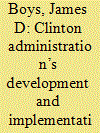| Srl | Item |
| 1 |
ID:
159939


|
|
|
|
|
| Summary/Abstract |
The concept of an assault on the critical infrastructure of the United States is often referred to as a ‘Cyber Pearl Harbor’. This implies that such an attack would come as a surprise. By 2016, however, few could claim to be surprised by such an event. This paper explains how the Clinton administration addressed cybersecurity in the 1990s as computers became an everyday item. With the benefits of this era, however, came potentially devastating implications for national security as the Clinton administration was required to confront a form of politically motivated violence unlike any that had been seen before Cyberterrorism.
|
|
|
|
|
|
|
|
|
|
|
|
|
|
|
|
| 2 |
ID:
168392


|
|
|
|
|
| Summary/Abstract |
A firestorm of protest greeted revelations of the rendition program when it was made public during the George W. Bush administration. The operational and political basis for the rendition initiative, however, had been established years before George W. Bush became president and was viewed as 'a new art form' by the Clinton administration. Despite significant efforts to distinguish between the two administrations, the evolution of the rendition initiative during the 1990s reveals far greater continuity than has been widely acknowledged. This paper examines the manner in which the Clinton administration utilized rendition in its own war on terror, years before George W. Bush came to power, with little public scrutiny or outrage.
|
|
|
|
|
|
|
|
|
|
|
|
|
|
|
|
| 3 |
ID:
179802


|
|
|
|
|
| Summary/Abstract |
Five decades before Donald Trump sought to make a virtue out of his unpredictable approach to policy, Richard Nixon adopted a similar stance in regard to foreign affairs that became known as The Madman Theory. The Nixon-Trump comparison in regard to foreign policy and their embrace of a high-risk approach to international negotiations once in office, follows striking parallels between the two men’s campaign pledges in 1968 and 2016. This paper examines the Madman Theory to consider its implementation by the Nixon administration and its subsequent adoption by the Trump White House as both leaders sought to rationalize their unpredictable approach to international flashpoints. Through a consideration of speeches, statements, transcripts and tweets it is possible to discern the manner in which both presidents embraced this approach to international relations, and the extent to which it served their interests as President of the United States.
|
|
|
|
|
|
|
|
|
|
|
|
|
|
|
|